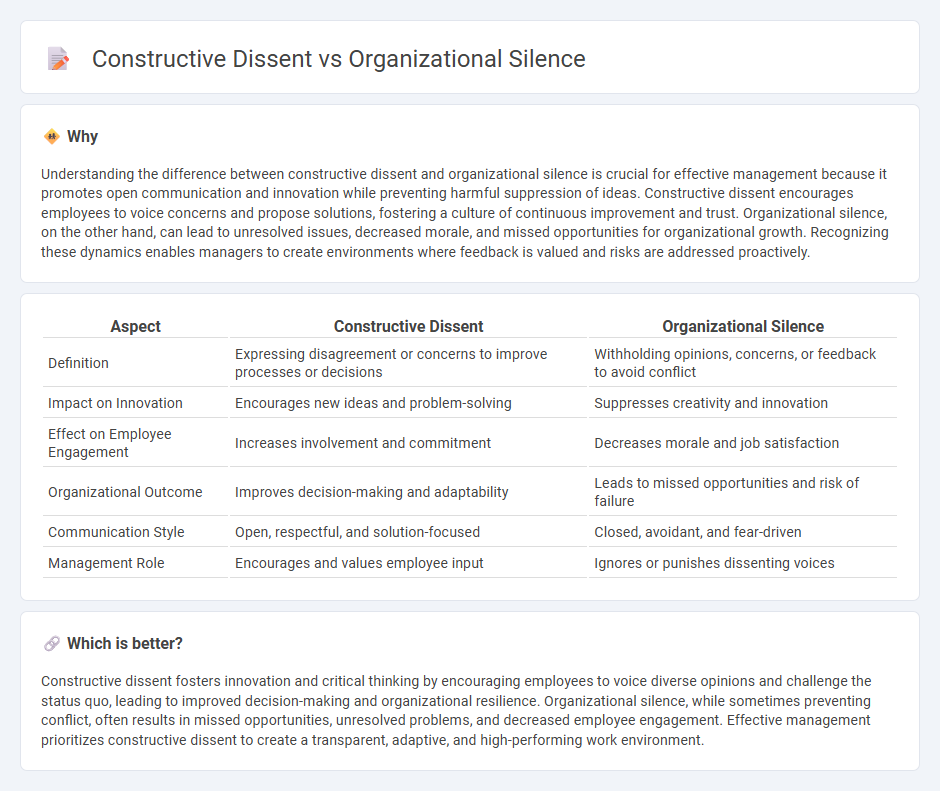
Constructive dissent refers to the open expression of differing opinions and critical feedback within an organization, fostering innovation and informed decision-making. Organizational silence occurs when employees withhold concerns or ideas due to fear of negative consequences, leading to missed opportunities and unresolved issues. Discover how balancing these dynamics can enhance management effectiveness and organizational culture.
Why it is important
Understanding the difference between constructive dissent and organizational silence is crucial for effective management because it promotes open communication and innovation while preventing harmful suppression of ideas. Constructive dissent encourages employees to voice concerns and propose solutions, fostering a culture of continuous improvement and trust. Organizational silence, on the other hand, can lead to unresolved issues, decreased morale, and missed opportunities for organizational growth. Recognizing these dynamics enables managers to create environments where feedback is valued and risks are addressed proactively.
Comparison Table
| Aspect | Constructive Dissent | Organizational Silence |
|---|---|---|
| Definition | Expressing disagreement or concerns to improve processes or decisions | Withholding opinions, concerns, or feedback to avoid conflict |
| Impact on Innovation | Encourages new ideas and problem-solving | Suppresses creativity and innovation |
| Effect on Employee Engagement | Increases involvement and commitment | Decreases morale and job satisfaction |
| Organizational Outcome | Improves decision-making and adaptability | Leads to missed opportunities and risk of failure |
| Communication Style | Open, respectful, and solution-focused | Closed, avoidant, and fear-driven |
| Management Role | Encourages and values employee input | Ignores or punishes dissenting voices |
Which is better?
Constructive dissent fosters innovation and critical thinking by encouraging employees to voice diverse opinions and challenge the status quo, leading to improved decision-making and organizational resilience. Organizational silence, while sometimes preventing conflict, often results in missed opportunities, unresolved problems, and decreased employee engagement. Effective management prioritizes constructive dissent to create a transparent, adaptive, and high-performing work environment.
Connection
Constructive dissent encourages open communication and critical feedback, which directly counters organizational silence by fostering an environment where employees feel safe to voice concerns and share innovative ideas. When organizational silence prevails, it suppresses dissenting opinions, leading to missed opportunities for problem-solving and continuous improvement. Effective management practices that promote constructive dissent reduce the risks associated with silence, enhancing decision-making quality and organizational resilience.
Key Terms
Voice Behavior
Organizational silence occurs when employees withhold ideas, concerns, or feedback, often due to fear of negative consequences or lack of trust, negatively impacting innovation and decision-making. Constructive dissent, a form of positive voice behavior, encourages employees to express differing opinions and challenge the status quo, fostering a culture of open communication and continuous improvement. Explore deeper insights into how voice behavior shapes organizational dynamics and performance.
Psychological Safety
Organizational silence occurs when employees withhold ideas or concerns due to fear of negative consequences, undermining psychological safety and stifling innovation. Constructive dissent encourages open dialogue and respectful disagreement, fostering a culture where psychological safety allows individuals to express diverse viewpoints without intimidation. Explore further how enhancing psychological safety can transform silence into valuable dissent within organizations.
Power Distance
Organizational silence occurs when employees withhold opinions due to fear of hierarchical repercussions, often intensified in high power distance cultures where authority is rarely questioned. In contrast, constructive dissent encourages open communication and critical feedback, fostering innovation by challenging decisions respectfully despite power asymmetries. Explore more about how power distance shapes these dynamics and impacts organizational effectiveness.
Source and External Links
Organizational Silence and Hidden Threats to Patient Safety - This article discusses organizational silence as a collective failure to address significant problems, focusing on factors that threaten patient safety in healthcare settings.
How to combat organisational silence? - This page explores ways to address organizational silence by promoting a fair and just culture, highlighting its impact on safety information reporting.
Organizational Silence Panel Discussion - This panel discussion features experts sharing their experiences and research on organizational silence, including its implications and challenges.
 dowidth.com
dowidth.com